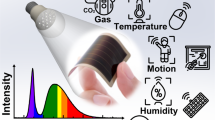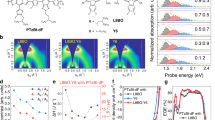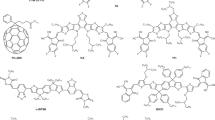Abstract
Organic photovoltaic cells are potential candidates to drive low power consumption off-grid electronics for indoor applications. However, their power conversion efficiency is still limited by relatively large losses in the open-circuit voltage and a non-optimal absorption spectrum for indoor illumination. Here, we carefully designed a non-fullerene acceptor named IO-4Cl and blend it with a polymer donor named PBDB-TF to obtain a photoactive layer whose absorption spectrum matches that of indoor light sources. The photovoltaic characterizations reveal a low energy loss below 0.60 eV. As a result, the organic photovoltaic cell (1 cm2) shows a power conversion efficiency of 26.1% with an open-circuit voltage of 1.10 V under a light-emitting diode illumination of 1,000 lux (2,700 K). We also fabricated a large-area cell (4 cm2) through the blade-coating method. Our cell shows an excellent stability, maintaining its initial photovoltaic performance under continuous illumination of the indoor light source for 1,000 hours.
This is a preview of subscription content, access via your institution
Access options
Access Nature and 54 other Nature Portfolio journals
Get Nature+, our best-value online-access subscription
$29.99 / 30 days
cancel any time
Subscribe to this journal
Receive 12 digital issues and online access to articles
$119.00 per year
only $9.92 per issue
Buy this article
- Purchase on Springer Link
- Instant access to full article PDF
Prices may be subject to local taxes which are calculated during checkout





Similar content being viewed by others
Data availability
The data that support the plots within this paper and other findings of this study are available from the corresponding author upon reasonable request.
References
Atzori, L., Iera, A. & Morabito, G. The internet of things: a survey. Comput. Netw. 54, 2787–2805 (2010).
Gubbi, J., Buyya, R., Marusic, S. & Palaniswami, M. Internet of things (IoT): a vision, architectural elements, and future directions. Future Gener. Comp. Syst. 29, 1645–1660 (2013).
Al-Fuqaha, A., Guizani, M., Mohammadi, M., Aledhari, M. & Ayyash, M. Internet of things: a survey on enabling technologies, protocols, and applications. IEEE Commun. Surv. Tut. 17, 2347–2376 (2015).
Khan, J. A., Qureshi, H. K. & Iqbal, A. Energy management in wireless sensor networks: a survey. Comput. Electr. Eng. 41, 159–176 (2015).
Yin, H. et al. Designing a ternary photovoltaic cell for indoor light harvesting with a power conversion efficiency exceeding 20%. J. Mater. Chem. A 6, 8579–8585 (2018).
Lee, H. K. H., Li, Z., Durrant, J. R. & Tsoi, W. C. Is organic photovoltaics promising for indoor applications? Appl. Phys. Lett. 108, 253301 (2016).
Minnaert, B. & Veelaert, P. A proposal for typical artificial light sources for the characterization of indoor photovoltaic applications. Energies 7, 1500–1516 (2014).
Freitag, M. et al. Dye-sensitized solar cells for efficient power generation under ambient lighting. Nat. Photon. 11, 372–378 (2017).
Teran, A. S. et al. Energy harvesting for GaAs photovoltaics under low-flux indoor lighting conditions. IEEE Trans. Electron. Dev. 63, 2820–2825 (2016).
Freunek, M., Freunek, M. & Reindl, L. M. Maximum efficiencies of indoor photovoltaic devices. IEEE J. Photovolt. 3, 59–64 (2013).
Minnaert, B. & Veelaert, P. Efficiency simulations of thin film chalcogenide photovoltaic cells for different indoor lighting conditions. Thin Solid Films 519, 7537–7540 (2011).
Mori, S. et al. Investigation of the organic solar cell characteristics for indoor LED light applications. Jpn J. Appl. Phys. 54, 071602 (2015).
De Rossi, F., Pontecorvo, T. & Brown, T. M. Characterization of photovoltaic devices for indoor light harvesting and customization of flexible dye solar cells to deliver superior efficiency under artificial lighting. Appl. Energy 156, 413–422 (2015).
Cutting, C. L., Bag, M. & Venkataraman, D. Indoor light recycling: a new home for organic photovoltaics. J. Mater. Chem. C 4, 10367–10370 (2016).
Cao, Y., Liu, Y., Zakeeruddin, S. M., Hagfeldt, A. & Grätzel, M. Direct contact of selective charge extraction layers enables high-efficiency molecular photovoltaics. Joule 2, 1108–1117 (2018).
Li, M. et al. Interface modification by ionic liquid: a promising candidate for indoor light harvesting and stability improvement of planar perovskite solar cells. Adv. Energy Mater. 8, 1801509 (2018).
Lee, H. K. H. et al. Organic photovoltaic cells—promising indoor light harvesters for self-sustainable electronics. J. Mater. Chem. A 6, 5618–5626 (2018).
Liu, X., Huettner, S., Rong, Z., Sommer, M. & Friend, R. H. Solvent additive control of morphology and crystallization in semiconducting polymer blends. Adv. Mater. 24, 669–674 (2012).
Lin, Y. Z. & Zhan, X. W. Non-fullerene acceptors for organic photovoltaics: an emerging horizon. Mater. Horiz. 1, 470–488 (2014).
Gupta, V. et al. Barium: an efficient cathode layer for bulk-heterojunction solar cells. Sci. Rep. 3, 1965 (2013).
Zhang, H. et al. Fullerene-free polymer solar cell based on a polythiophene derivative with an unprecedented energy loss of less than 0.5 eV. J. Mater. Chem. A 4, 18043–18049 (2016).
Xu, X. et al. Realizing over 13% efficiency in green-solvent-processed nonfullerene organic solar cells enabled by 1,3,4-thiadiazole-based wide-bandgap copolymers. Adv. Mater. 30, 1703973 (2018).
Zhang, J., Tan, H. S., Guo, X., Facchetti, A. & Yan, H. Material insights and challenges for non-fullerene organic solar cells based on small molecular acceptors. Nat. Energy 3, 720–731 (2018).
Aoki, Y. Photovoltaic performance of organic photovoltaics for indoor energy harvester. Org. Electron. 48, 194–197 (2017).
Lechêne, B. P. et al. Organic solar cells and fully printed super-capacitors optimized for indoor light energy harvesting. Nano Energy 26, 631–640 (2016).
Zhang, M., Guo, X., Ma, W., Ade, H. & Hou, J. A large-bandgap conjugated polymer for versatile photovoltaic applications with high performance. Adv. Mater. 27, 4655–4660 (2015).
Zhang, H. et al. Over 14% efficiency in organic solar cells enabled by chlorinated nonfullerene small-molecule acceptors. Adv. Mater. 30, 1800613 (2018).
Zhang, S., Qin, Y., Zhu, J. & Hou, J. Over 14% efficiency in polymer solar cells enabled by a chlorinated polymer donor. Adv. Mater. 30, 1800868 (2018).
Zhao, F. et al. Single-junction binary-blend nonfullerene polymer solar cells with 12.1% efficiency. Adv. Mater. 29, 1700144 (2017).
Lin, Y. et al. Mapping polymer donors toward high-efficiency fullerene free organic solar cells. Adv. Mater. 29, 1604155 (2017).
Lin, Y. et al. An electron acceptor challenging fullerenes for efficient polymer solar cells. Adv. Mater. 27, 1170–1174 (2015).
Nikolis, V. C. et al. Reducing voltage losses in cascade organic solar cells while maintaining high external quantum efficiencies. Adv. Energy Mater. 7, 1700855 (2017).
Vandewal, K., Benduhn, J. & Nikolis, V. C. How to determine optical gaps and voltage losses in organic photovoltaic materials. Sustain. Energy Fuels 2, 538–544 (2018).
Wang, Y. et al. Optical gaps of organic solar cells as a reference for comparing voltage losses. Adv. Energy Mater. 8, 1801509 (2018).
Yao, J. et al. Quantifying losses in open-circuit voltage in solution-processable solar cells. Phys. Rev. Appl. 4, 014020 (2015).
Liu, J. et al. Fast charge separation in a non-fullerene organic solar cell with a small driving force. Nat. Energy 1, 16089 (2016).
Qian, D. et al. Design rules for minimizing voltage losses in high-efficiency organic solar cells. Nat. Mater. 17, 703–709 (2018).
Ran, N. A. et al. Harvesting the full potential of photons with organic solar cells. Adv. Mater. 28, 1482–1488 (2016).
Li, W. et al. Molecular order control of non-fullerene acceptors for high-efficiency polymer solar cells. Joule 3, 1–15 (2018).
Zhang, J. et al. Enhancing performance of large-area organic solar cells with thick film via ternary strategy. Small 13, 1700388 (2017).
Zhang, K. et al. Efficient large area organic solar cells processed by blade-coating with single-component green solvent. Solar RRL 2, 1700169 (2018).
Vandewal, K., Tvingstedt, K., Gadisa, A., Inganas, O. & Manca, J. V. On the origin of the open-circuit voltage of polymer–fullerene solar cells. Nat. Mater. 8, 904–909 (2009).
Cowan, S. R., Roy, A. & Heeger, A. J. Recombination in polymer–fullerene bulk heterojunction solar cells. Phys. Rev. B 82, 245207 (2010).
Elumalai, N. K. & Uddin, A. Open circuit voltage of organic solar cells: an in-depth review. Energy Environ. Sci. 9, 391–410 (2016).
Guo, B. et al. High efficiency nonfullerene polymer solar cells with thick active layer and large area. Adv. Mater. 29, 1702291 (2017).
Green, M. A. Solar-cell fill factors—general graph and empirical expressions. Solid State Electron. 24, 788–789 (1981).
Zhou, Y. H. et al. All-plastic solar cells with a high photovoltaic dynamic range. J. Mater. Chem. A 2, 3492–3497 (2014).
Acknowledgements
The authors acknowledge financial support from National Natural Science Foundation of China (Grant nos. 51673201 and 91633301), Beijing National 434 Laboratory for Molecular Sciences (Grant no. BNLMS-CXXM-201903), Chinese Academy of Sciences (Grant no. XDB12030200), the Swedish Research Council VR (2018-06048), the Swedish Energy Agency Energimyndigheten (2016-010174) and the Swedish Government Strategic Research Area in Materials Science on Functional Materials at Linköping University (Faculty Grant no. SFO-Mat-LiU #2009-00971). F.G. is a Wallenberg Academy Fellow and O.I. is a Wallenberg Academy Scholar.
Author information
Authors and Affiliations
Contributions
Y.C. and J.H. designed the experiments. Y.C. synthesized the acceptor material IO-4Cl. Y.C. fabricated the solar cells and carried out the published device performance measurements. F.G. led the work at Linköping. J.B. initiated the indoor characterization, performed the first indoor device measurements and contributed to the design of the indoor measurements. Y.W. measured the FTPS-EQE and EQEEL. Y.X. performed the DFT calculations. B.G. carried out photo-CELIV (charge extraction by linearly increasing voltage) measurements. C.Y. provided atomic force microscopy images. O.I. contributed to the data interpretation. S.Z. analysed the dependence of the PCEs on Rs under the indoor and AM 1.5G conditions. Y.C., H.Y., F.G. and J.H. wrote the paper. All the authors discussed the results and commented on the manuscript.
Corresponding authors
Ethics declarations
Competing interests
J.B. and O.I. are co-founders of the company Epishine AB focused on commercializing OPV for indoor applications.
Additional information
Publisher’s note: Springer Nature remains neutral with regard to jurisdictional claims in published maps and institutional affiliations.
Supplementary information
Supplementary Information
Supplementary Figs. 1–27, Supplementary Notes 1–5, Supplementary Tables 1–4 and Supplementary refs. 1–48.
Rights and permissions
About this article
Cite this article
Cui, Y., Wang, Y., Bergqvist, J. et al. Wide-gap non-fullerene acceptor enabling high-performance organic photovoltaic cells for indoor applications. Nat Energy 4, 768–775 (2019). https://doi.org/10.1038/s41560-019-0448-5
Received:
Accepted:
Published:
Issue Date:
DOI: https://doi.org/10.1038/s41560-019-0448-5
This article is cited by
-
Increase in the efficiency and stability of large-area flexible organic photovoltaic modules via improved electrical contact
Nature Energy (2024)
-
Indoor photovoltaic energy harvesting based on semiconducting π-conjugated polymers and oligomeric materials toward future IoT applications
Polymer Journal (2023)
-
Organic laser power converter for efficient wireless micro power transfer
Nature Communications (2023)
-
Key molecular perspectives for high stability in organic photovoltaics
Nature Reviews Materials (2023)
-
Controllable-doping ambipolar conjugated polymeric semiconductors towards simplified-constructed organic logic circuits with excellent comprehensive performance
Science China Materials (2023)



